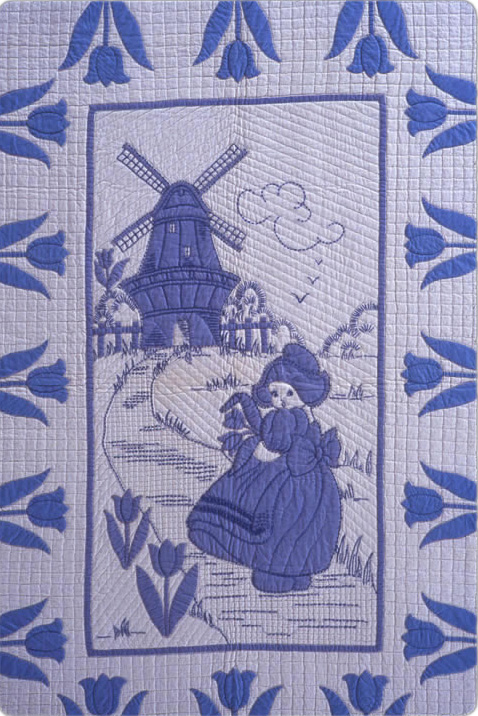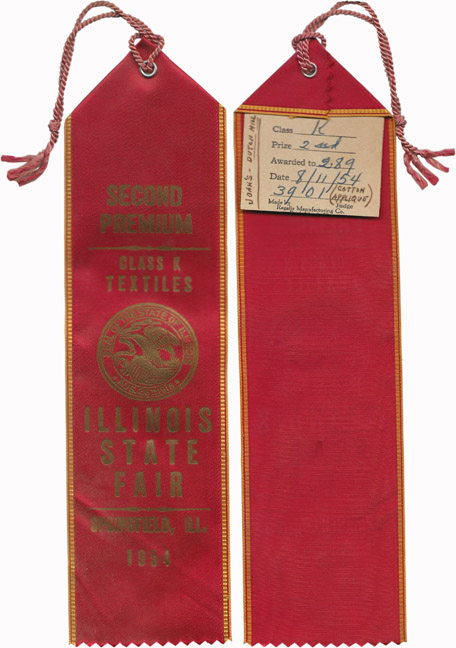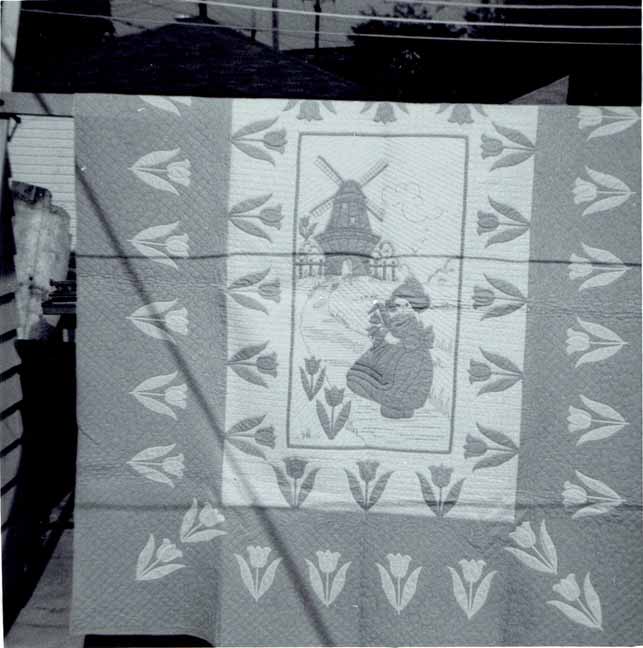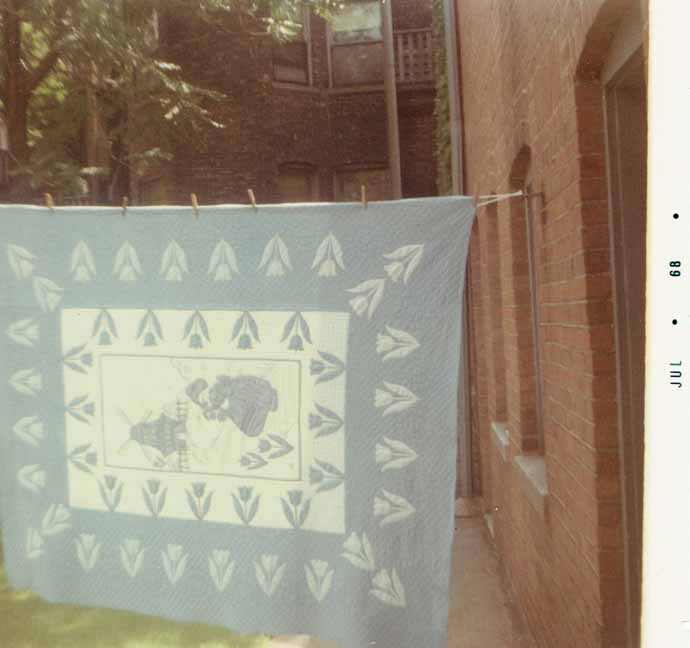
QUILT INDEX RECORD
18-14-60
Essay:
This quilt made for a grand-daughter is another example of Gasperik's ability to successfully re-work a quilt kit (Bucilla Crib #2271) by adding a border and quilting more densely than the kit prescribed. The tulip hovering at a rakish angle next to the windmill is also Gasperik's own addition.
Where are the records for this quilt housed?
Mary Gasperik Legacy Project
Who documented this quilt?
Mary Gasperik Private Collection
Gasperik Legacy Project Number:
018
This is a:
Finished quilt
Quilt's title:
Dutch Girl
Owner's name for quilt:
Dutch Girl With Tulips
How wide is the quilt?
66 inches
How long is the quilt?
82 inches
Shape of edge:
Straight
Shape of corners:
Straight
What color is the quilt?
Blue or Navy; White
Overall color scheme:
Light or pastel colors
Quilt's condition:
Excellent/like new
Time period:
1930-1949
When was the quilt finished?
1950
Family/owner's date for quilt:
1950
Date estimated by an antique dealer, quilt historian or appraiser:
1935-1940
Who estimated the quilt's date?
Merikay Waldvogel
Further information concerning dates:
Finding copyright date of the kit will confirm the date the pattern became available to Gasperik, if not the date when she made the quilt.
Describe the quilt's layout:
Medallion or framed center
Subject of the quilt:
Dutch Girl with Tulips and Windmill
Describe the borders:
Wide outer blue border with white appliqued tulips; narrower inner white border with blue appliqued tulips.
Fiber types used to make the quilt top:
Cotton
Fabric styles used in the quilt top:
Solid/plain
Embellishment techniques used to make the quilt top:
Embroidery
Materials used to make the back:
Cotton
Materials used in the quilt binding:
Cotton
What kind of filling is used in the quilt?
Cotton
How thick is the quilt?
Thin (Less than 3/16
How are the layers held together?
Hand quilting
Color of thread used in the quilting:
white
Number of quilting stitches per inch, place 1:
10
Number of quilting stitches per inch, place 2:
11
Can you see any knots on the front or back of the quilt?
no
Quilting designs used, overall motifs:
Outline
Quilting designs used, decorative motifs:
Wreaths
Quilting designs used, background fills:
Grid/crosshatch; Parallel lines
Describe the quilting designs used:
Quilted wreaths between each upright tulip on the border.
Features or notes about the quilt's appearance, materials, or construction:
Gasperik added to the quilt kit an extra border; the color blue is slightly darker than the blue of the kit-supplied fabrics.
Quilt top made by:
Gasperik, Mary
Quilted by:
Gasperik, Mary
Where the quilt was made, city:
East Hazelcrest
Where the quilt was made, county:
Cook County
Where the quilt was made, state:
Illinois (IL)
Where the quilt was made, country:
United States
How was this quilt acquired?
Gift
Tell the story of how the quilt was obtained:
Selected by Doris Gasperik during a division of Gasperik quilts after Mary died.
Describe anything about the history of the quilt that wasn't already recorded in a previous field:
Following the Gasperik quilt show, in California in 1992, at which time Mary Gasperik's grandchildren reconnected, the quilt was given by Elmer and Doris Gasperik's heirs to their cousin Joanne Gasperik.
Why was the quilt made?
Baby or crib
The quilt was made to be used for:
Bedding, special occasion
Quilt is presently used as:
Keepsake/memento
Describe present uses of the quilt:
Mary's grandchildren regard her quilts as a unique collection to be preserved and appreciated.
Where did the maker get their materials?
Purchased new
Where did the maker find their pattern?
Commercial/Published source: Kit
Commercial name of the pattern for the top:
Bucilla Crib #2271
What is the commercial name of the quilting design used for this quilt?
Quilted tulips, see: Border D10 from Grandmother's Perforated Quilting Patterns;
For Double Feathered Wreath between tulips, See Pattern A in Grandmother Clark's Quilting Designs Actual Size Patterns Book #22 (WLM Clark, St. Louis, MO)
Describe anything about the design of the quilt that wasn't already recorded in a previous field:
For comparison purposes, Salser purchased a quilt in the same design--and found Bucilla Crib #2271 printed on the selvedge. No pattern name.
Exhibitions where this quilt was displayed:
Illinois State Fair - 1954
The Quilts of Mary Gasperik, Ravenswood Historic Site, Livermore, CA, March 14-15, 1992.
Florida exhibit called A Celebration of Quilts and the Women Who Made Them, Naples Historical Society, Inc. and The Naples Quilters Guild, Inc. January 25-29, 2005.
Contests entered:
That this quilt won a prize at an Illinois State Fair is evidenced by an undated family newspaper clipping which reads: "Mrs. Stephen Gasperik, our local quilting expert, continued her winning ways at the Illinois State Fair this year by winning 2 first & a second prize on her three entries. A first was awarded her "Double Feather Star" design which she copied from a book. It was originally designed in 1835 by a bridegroom for his bride. Another first went to her beautifully original "Indian Boys" which she made for her grandson. A second prize was awarded to her "Dutch Girl" which she made for her granddaughter." This may have been the 1954 Illinois State Fair because among Doris Gasperik's collection of quilt prize ribbons is a 1954 blue ribbon with attached cardboard on which it is noted in pencil that Michael's Indians quilt was the particular quilt which won that ribbon: first prize, best novelty, Illinois State Fair, 1954.
Publications (including web sites) where this quilt or maker was featured:
Merikay Waldvogel and Barbara Brackman. Patchwork Souvenirs of the 1933 Chicago World's Fair, (Nashville, TN: Rutledge Hill Press, 1993)102-103.
Merikay Waldvogel "One American Dream Comes True", Quilters Newsletter Magazine, March 2008, 46-49.
Related items such as diaries, obituaries, wills, household inventories, or pictures of the quiltmaker:
Quilt made from same kit (Collection of Susan Salser). Woman's Day February 1943 pages 22-25 "Prize-Winning Needlework" about the Woman's Day National Needlework Exhibition. In a photograph on page 24 showing some of the quilt display a small portion of a Dutch Girl quilt can be seen. This is not to suggest that the Gasperik quilt itself is in that picture, it is cited only to aid in determining the time period when quilts of such design were made.
Undated family newspaper clipping which reads: "Mrs. Stephen Gasperik, our local quilting expert, continued her winning ways at the Illinois State Fair this year by winning 2 first & a second prize on her three entries. A first was awarded her "Double Feather Star" design which she copied from a book. It was originally designed in 1835 by a bridegroom for his bride. Another first went to her beautifully original "Indian Boys" which she made for her grandson. A second prize was awarded to her "Dutch Girl" which she made for her granddaughter."
Ownership of this quilt is:
Private
Quilt owner's name:
Joanne Gasperik
Quilt owner's country:
United States
Person filling out this form is:
Relative of quiltmaker; Author/researcher
If you are a relative of the quiltmaker, how are you related? The quiltmaker is my:
Grandmother
Describe the relationship to the quilt's maker:
Grand-daughter Susan Salser began this research effort in 1991, after she and her two sisters divided up the quilts which belonged to their mother (Elsie Gasperik Krueger) who died in 1988. Her ongoing research has been fruitful and interesting.
Quiltmaker's maiden name:
Mihalovits, Maria
Quiltmaker's gender:
Female
Quiltmaker's birth date:
01/25/1888
Quiltmaker's birthplace, country:
Hungary
Quiltmaker's marriage date(s):
11/18/1906
Quiltmaker's date of death:
05/25/1969
Quiltmaker's ethnic background/tribal affiliation:
Hungarian
Quiltmaker's educational background:
Elementary School
In which kind of environment did the quiltmaker live?
Rural
Quiltmaker's city:
East Hazelcrest
Quiltmaker's county:
Cook
Quiltmaker's state:
Illinois (IL)
Quiltmaker's country:
United States
Quiltmaker's father's name:
Mihalovits, Istvan
Quiltmaker's father's birthplace:
Hungary
Quiltmaker's father's ethnic/tribal background:
Hungarian
Quiltmaker's mother's name:
Mihalovits, Vidoszava
Quiltmaker's mother's birthplace:
Hungary
Quiltmaker's mother's ethnic/tribal background:
Hungarian
Quiltmaker's spouse's/spouses' and /or partner's/partners' name(s):
Gasperik, Stephen
Quiltmaker's spouse's/spouses' and/or partner's/partners' ethnic/tribal background:
Hungarian
Quiltmaker's spouse's/spouses' and/or partner's/partners' occupation:
Milk Dealer/Grocery Store Owner/Butcher
Number of children:
3
How many of the quiltmaker's children were girls?
1 (Elsie 1909-1988)
How many of the quiltmaker's children were boys?
2 (Elmer and Stephen)
How did the quiltmaker learn to quilt?
From guild or club member; Self-Taught
When did the quiltmaker learn to quilt?
Age 40-49
Why does the quiltmaker quilt?
Pleasure; Other
Other notes on how the quiltmaker learned, and how and why they quilt:
To exhibit in shows held by her Tuley Park quilt club in Chicago, the Detroit News quilt show in Detroit, many Illinois State Fairs, at least one Indiana State Fair. She entered quilts in at least 2 Chicago department store contests. She made at least one quilt and one quilt top specifically for the 1939 New York Worlds Fair quilt contest. She also made children's quilts specifically for grandchildren and great-grandchildren; and wedding and wedding anniversary quilts for her son Elmer and grand-daughter Karen. Primarily, she wanted to make quilts because it was her life passion and her greatest talent. The occasions and venues to show them presented themselves. It should be noted that prior to Mary's emigration to America in late 1904, at age 16, she was an apprenticed needleworker in her native Hungary. The intricate and colorful floral embroideries traditional to Hungary lend themselves especially well to applique, the quilt style Mary preferred.
Does/did the quiltmaker belong to a group? Name of the group?
Tuley Park Quilt Club and Detroit News Quilt Club
Does/did the quiltmaker belong to a group?
Southside Chicago and Detroit MI
What are the main activities of the group?
Chicago group met to quilt and held periodic quilt shows; Detroit group held national exhibits and contests.
Estimated number of quilts made by this quiltmaker:
more than 50
Does/did the quiltmaker sell quilts?
no
Does/did the quiltmaker teach quilting?
no
Who photographed this quilt?
Don Gonzalez
Access and copyright information:
Restricted
Copyright holder:
Susan Salser
Details
Cite this Quilt
Gasperik, Mar. Dutch Girl . 1950. From Mary Gasperik Legacy Project, Mary Gasperik Private Collection. Published in The Quilt Index, https://quiltindex.org/view/?type=fullrec&kid=18-14-60. Accessed: 04/25/24
-
Gallery
Gasperik 05: Gifts for Children
Waldvogel, Merikay
-
Exhibit
The Quilts of Mary Gasperik
Salser, Susan
-
Ephemera
The Quilts of Mary Gasperik
Salser, Susan
-
Essay
Mary Gasperik and The Illinois State F...
Salser, Susan
-
Ephemera
Mrs. Stephen Gasperik…
Chicago area newspaper
-
Gasperik, Mary Quiltmaker
Mary Gasperik Legacy Project



